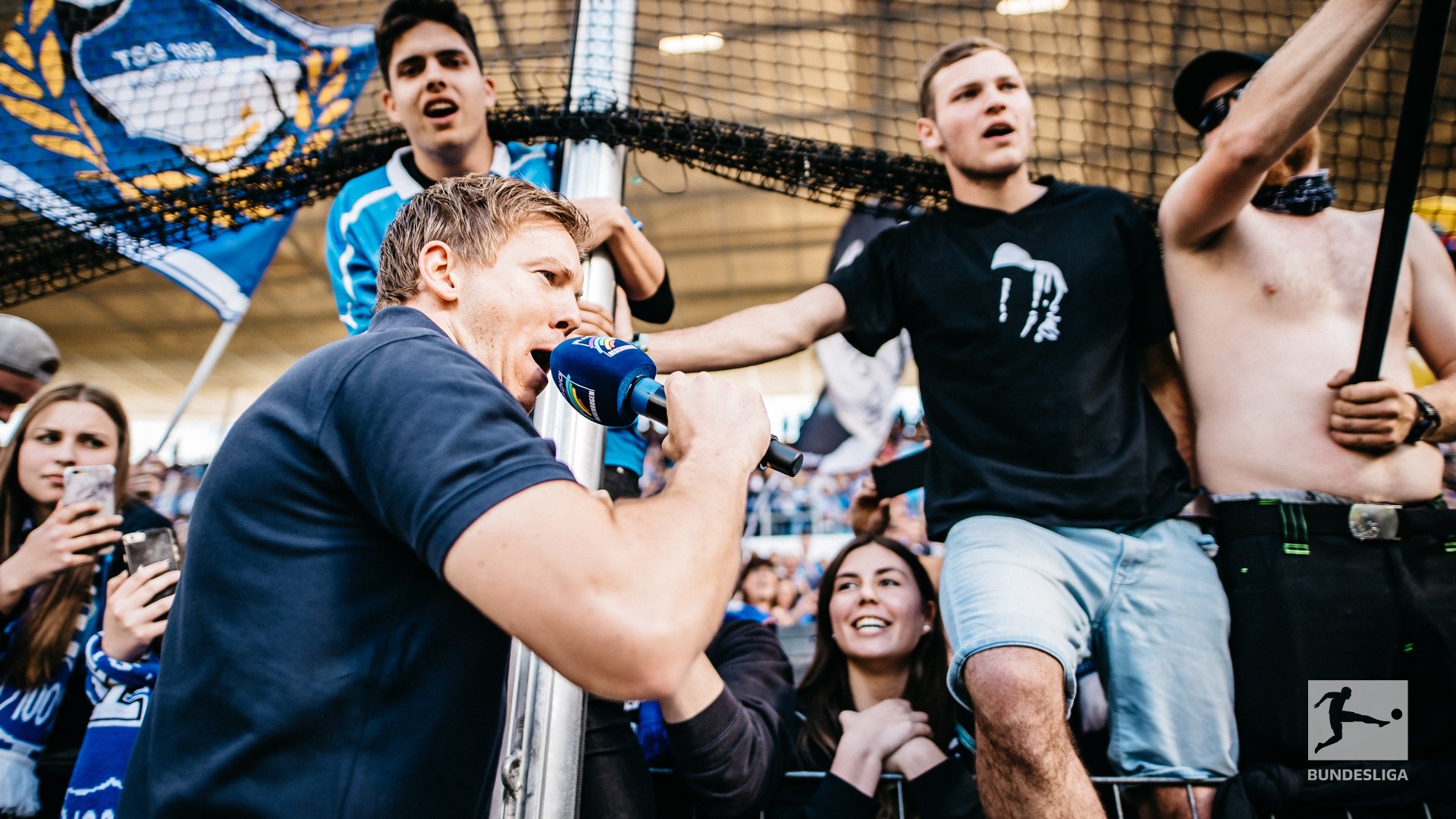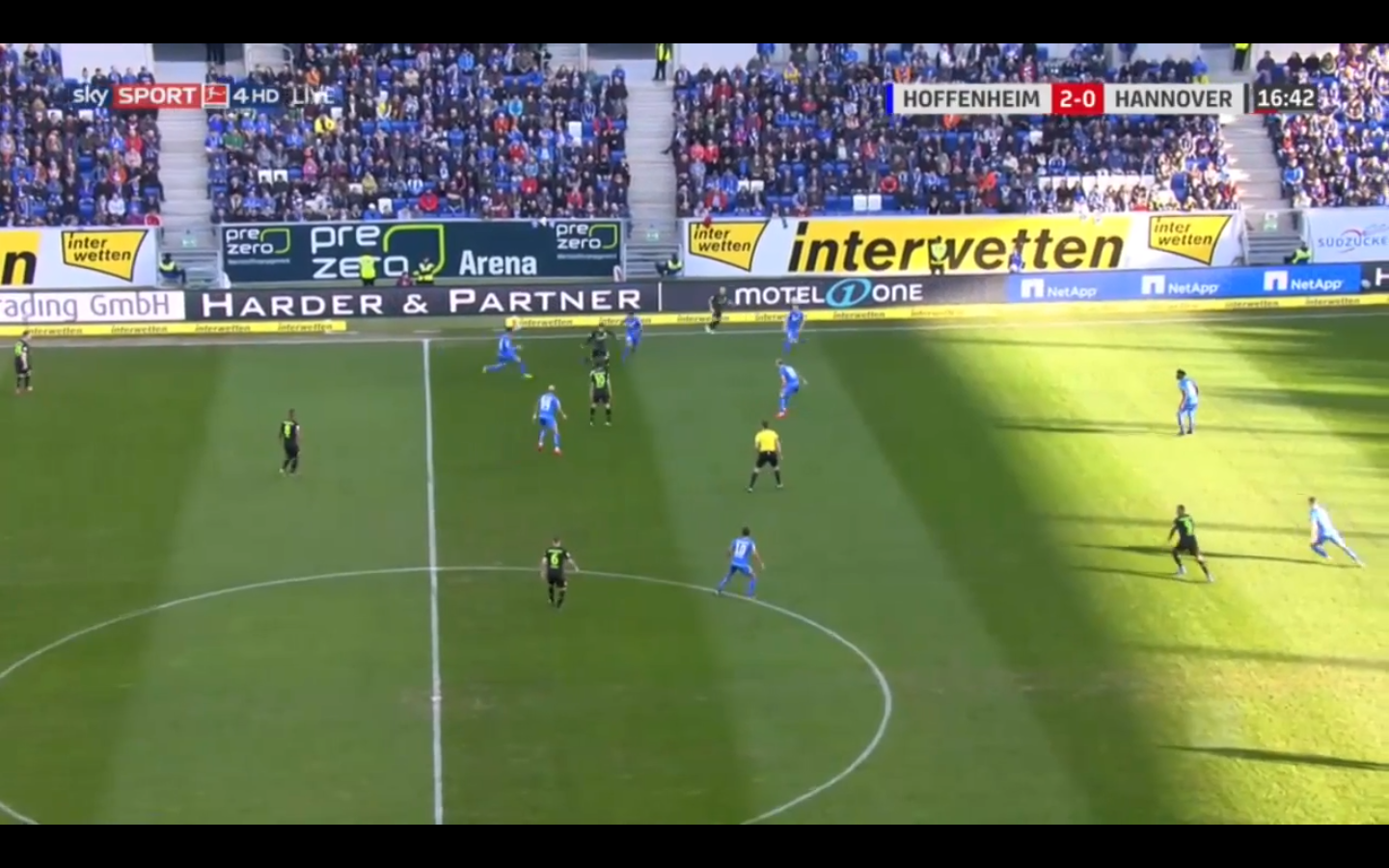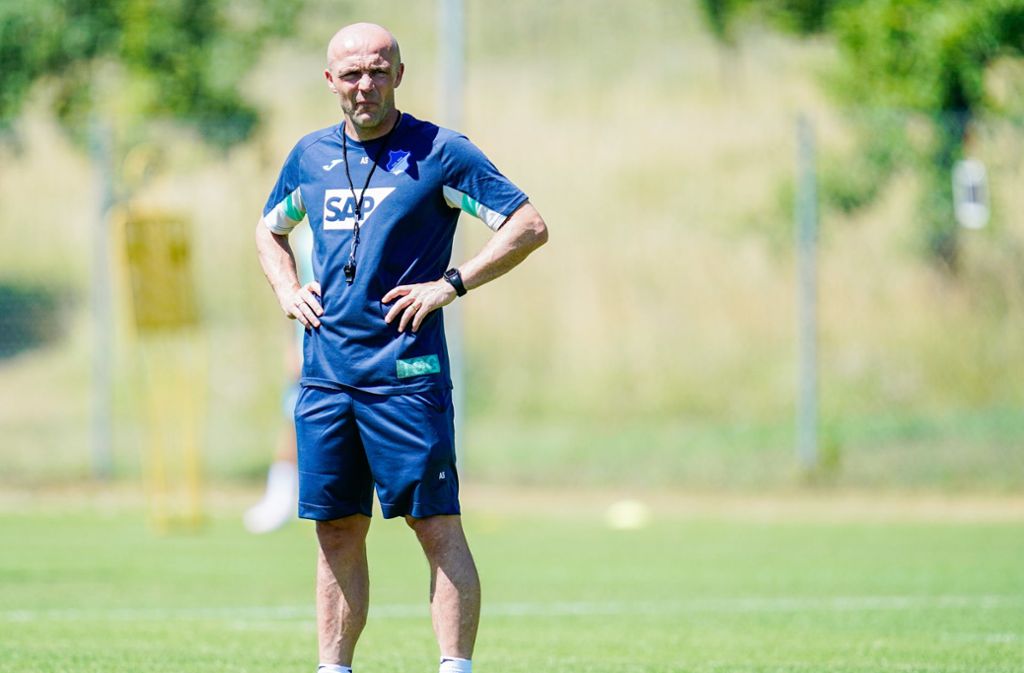Hoffenheim’s awe-inspiring style under Julian Nagelsmann
Julian Nagelsmann has developed into one of the most refined managers in the Bundesliga as after keeping the side safe, he then led them to back-to-back UEFA Champions League qualifications. His ability to develop players into more well-rounded versions of themselves while maintaining and improving a dominant style of play despite the yearly departures in his playing staff is exemplary. He has earned a move to RB Leipzig who will offer a fine array of young talent from their feeder clubs and their astute scouting policy as he turned Hoffenheim into one of the more progressive European sides with his unique training methods and apparatus.
HIGHLY POSITIONED CENTRE-BACKS
Nagelsmann’s side utilise a 3+1 build-up shape as the back three will have a pivote who will normally be Florian Grillisitch or Kerem Demirbay as an option to play through the middle. In the build-up phase and approach play phase, Hoffenheim prefer to push the opposition back and control the game with their three-chain moving near the half-way line or into the opposition half. The centre-backs are given freedom to drive into space and engage markers to then work a pass into space or play passes through the lines. Kevin Vogt has been given the role of the de facto modern-day libero as in Nagelsmann’s first season, he had the most passes in his own half in the Bundesliga.
Vogt will normally play wall-passes to the six space which will move markers to the six space before playing balls through the opened space into the front line. If Vogt regains the ball deep in his own half, he normally plays direct balls to Nico Schulz on the flank to evade pressure. The back three will patiently circulate the ball amongst each other while also playing balls back to Oliver Baumann who is adept at short passes and long-passes with his feet and creating overloads with the three-chain in early build-up play.
HALF SPACE COMBINATIONS AND POSITIONAL PLAY
Hoffenheim engineer connections between the three chain and the attackers through clever half-space combinations as they will always have two attackers flanking the central striker in the half-space to receive possession. In the photo above, Andrej Kramaric has dropped deep to receive the ball from the back three to drive into space as he has direct options with Joelinton waiting to receive possession in the half-space and the wing-back on the outside. Nagelsmann’s side frequently work connections from the deeper positions into the half-space then to the lateral space and vice versa.
Hoffenheim seek to stretch the pitch with their widely and highly positioned wing-backs in Pavel Kaderabek and Schulz as the centre-backs can work early balls to them before they work one-touch one-twos with the players in the half-spaces. The half-spaces are an integral facet in all of Hoffenheim’s play with the ball as they can be used to play out of pressure and play the wing-backs into space from the deeper areas in build-up play. They can also be used to work quick combinations in the final third during approach play so the wing-backs can generate space for low crossing opportunities.
Hoffenheim normally use three prototype strikers in Ishak Belfodil, Joelinton and Kramaric with the third striker dropping deeper while the Brazilian is gifted in receiving passes in pockets of space in the centre and in the half-spaces. Nagelsmann’s side worked the ball with such pace and coordination that it was difficult for the opposition to track the passing moves. In the photo above, it is imperative to notice how the half-spaces provide direct outlets for the highly placed defenders as Nagelsmann uses these areas to connect defence and attack.
Above is another situation with Kerem Demirbay in possession as Joelinton is showing for the ball in the half-space while there is another striker positioned in the ball-far half-space with the wing-back establishing width. Werder Bremen are switching from their high press into their 5-4-1 low block as Hoffenheim have established numerical superiority in between the lines. The player spacing is adequate for combinations with the central striker dragging his centre-back away from the ball-far half-space creating space for the player positioned there while maintaining a body shape for a run in behind. The positional play in this situation is impressive as Bremen adjust to defend the player in possession with majority of their players watching the ball as Hoffenheim maintain their positions.
HOFFENHEIM DEFENSIVE SHAPE
Nagelsmann’s Hoffenheim normally defended in a rigid and tight 5-3-2, encouraging the opposition to play the ball out wide as they were suffocated in the central spaces. In the photo above, Hoffenheim have denied their opponents access into the central spaces - especially into the six space – as they prepare to assert lateral pressure in a 3v3 wide situation or in a 3v2 if the wide attacker shifts from marking his centre-back into cutting out the passing lane to him rendering him obsolete.
This 5-3-2 defensive shape allows Hoffenheim to transition into the lateral press to great effect as if their opponents switch the ball, Hoffenheim simply shift with their attacker marking the ball-far centre-back, ball-far wide midfielder marking the wing-back with the opposite midfielder closing down the six space while the wing-back will continue to mark his attacker. In the above picture it is also important to assess that the ball-near wide midfielder is blocking the direct passing lane into the striker, forcing the striker to drop off the centre-back which liberates the centre-back granting Hoffenheim further numerical and spacial dominance in the area. The Hoffenheim three-chain would be in a 3v1 against the striker while if the opposition manage to work the ball to the more deeply positioned supporting striker, they will be able to hunt the ball in packs and win possession to establish a break.
Above, Hoffenheim are in their 5-3-2 as they press the opposition, the striker has left his marker and moved to press the keeper to force a long ball or a ball out wide to the full-back where Hoffenheim’s wing-back will push up to mark him. They have worked are 3v2 situation in midfield to deny the goalkeeper access into midfield while they can work a 3v2 overload on the left-flank to lateral press the ball as they will have the same situation on the opposite flank with the deeply positioned wing-back out of the picture.
HOFFENHEIM PRESSING
Hoffenheim press in a high 5-3-2 shape in a man-orientated fashion as their three centre-backs push up to constrain the central spaces and force the opposition out wide. Their two forwards push up to mark the centre-backs with one of their midfielders moving up to mark the opposition deepest lying midfielder. The wing-backs will push up to mark the opposition fullbacks as they will engage their markers when the ball is played out wide. Nagelsmann’s side can also switch to a 4-3-3 in the pressing phase with one of their midfielders or a deeply-positioned Kramaric moving into the attacking line. Kevin Vogt or another centrally positioned centre-back will move into the midfield line in the six space with the rest of the defenders creating a four chain.
In the picture above, the two attackers are pressing the centre-backs as Hoffenheim’s most highly positioned midfielder has followed the opposition’s deepest-lying midfielder into his cover shadow. Hoffenheim’s two other midfielders are marking Bayer Leverkusen’s two other midfielders while the wing-backs have pushed up to mark the fullbacks. Interestingly, the player in possession seeks to turn out of pressure as his passing options are limited, the left-sided attacker and ball-near midfielder are preparing to close him down in a 3v1 situation while cutting out his direct passing lane to win possession. The midfielder has already shifted from his man-marking responsibility to push up against the player in possession. If the player in possession manages to complete a pass, Hoffenheim will aggressively hunt the ball in packs until they regain possession.
Hoffenheim have certain pressing triggers as back passes will cause Hoffenheim to move their line of pressure higher as one of the attackers will press the keeper. Hoffenheim will also tease passes in between the lines which will trigger the midfielders into closing the space to win possession. Nagelsmann has previously spoken of his preference for interceptions rather than tackles as the former allows his players more control of the ball and the next action as his side seek to create goalscoring opportunities from pressing situations.
HOFFENHEIM LATERAL PRESSURE
Hoffenheim put concerted effort in lateral pressure as they force the opposition into the wide areas and laterally press in order to win turnovers. The ball near wide players including the attacker, midfielder and wing-back will push out wide to win possession as the team will adapt by the ball-far midfielder and striker moving inside. Nagelsmann’s side seek to constrain the space to prevent wide-build-up and deny the opposition the opportunity to play a diagonal and switch play. In the above picture, Hoffenheim have worked a 5v3 overload with direct pressure on the ball while they have enclosed the space and limited the options for the player in possession.
Vogt has pushed up from his role in the back three to facilitate the overload and close the passing lane into the striker. It is intriguing to notice how the passing lanes to players outside the space have been closed while the players who are in direct attacking positions have markers tracking them. Hoffenheim have constrained the space in order to win a turnover and counter at pace to create opportunities. Nagelsmann’s player spacing and overloads are astutely positioned for a turnover as Hoffenheim can work passing combinations and spread play to progress into the opposition half quickly.
Above is a picture of Hoffenheim forcing the opposition into the lateral areas early in the pressing phase and then shifting out wide to force a long ball. Nagelsmann’s Hoffenheim have spent the ensuing three years since his appointment perfecting the essential tenets of his 5-3-2 defensive shape. One of these essential tenets is shifting pressure into the wide areas as the opposition seek to move possession into the wide areas to find gaps in their defensive structure. In the photo above, Hoffenheim’s two midfielders have shifted into the wide areas as the ball-near attacker has shifted into the wide positions while the other attacker is tracking his man into the wide area.
Hoffenheim have worked another 5v4 overload as the wing-back and wide centre-back have also pushed up to mark the opposition attackers. The ball-far midfielder has tucked in to prevent direct access into the central spaces. Hoffenheim are hunting the ball in packs as their whole team is geared to winning possession and constraining space in the wide areas for the turnovers. The ball-far attacker, midfielder and wing-back are also positioned well in case of a switch ball as they will be able to shift the pressure phase to the opposite flank seamlessly.
HOFFENHEIM COUNTER-PRESS
An essential principle of Nagelsmann’s Hoffenheim is their counter-pressing as they push the centre-backs high and have highly placed wing-backs. Once they lose possession, they will counter-press aggressively as their closest attackers to the opposition player in possession will switch and directly pressure the ball while other attackers restrict the passing lanes. Hoffenheim’s three chain will maintain their high positioning as they are well-schooled at stepping out of position to retrieve and recycle possession. Counter-pressing is also used as a form of chance creation as Hoffenheim play quick and direct combinations after winning possession to play the ball into the box for one of their strikers. The attackers are also willing to track back over short distances to create overloads and regain possession by attacking the opponent’s blind side.
In the photo above, Hoffenheim have lost possession with their wing-backs in the higher areas as their three-chain are closer to the half-way line. To prevent a counter-attack they have counter-pressed as they initially work a 3v1/4v1 situation with the player in possession. The opposition player in possession is hemmed into tight quarters with his passing options restricted as Hoffenheim have adjusted well to the turnover. One Hoffenheim player is directly pressuring the ball, his teammates are closing in from the opposition player’s blind-sides. A pass back to the central defender is teased but this will trigger the Hoffenheim attacking block to move higher and continue pursuing possession.
It is essentially a 7v7 scenario in the opposition half as Hoffenheim are tasked with closing down spaces and direct passing lanes rather marking men as they have left players in ample space in order to pressure the ball. The player in possession can turn or hold the ball to wait for support but Nagelsmann’s side have a greater chance of winning possession and creating a goalscoring opportunity. The wide centre-back has also moved up to act as press security and cover for the ball-near wing-back as this is facilitated by the deepest-lying midfielder moving into the three-chain to cover for him. The centre-backs and wing-backs maintaining their high positions and not instantly retreating allows Hoffenheim to suffocate their opponents and constrain the space to regain possession quickly.
HOFFENHEIM QUICK COMBINATION PLAY
Nagelsmann’s team are well drilled with quick combination play as centre-backs play the early ball through the lines to draw opponents and create space for the receiver to lay off the ball. One touch passing and movement in between the lines is crucial before Hoffenheim spread play to the flanks where the wing-backs will cross for the attackers who make runs into the box. The early pass in between the lines to a midfielder dropping into the eight space for the midfielder to play a one-touch layoff to the six space for the deepest-lying midfielder to spread the ball out wide or chip behind a defence that has pushed up high is one of Hoffenheim’s favourite quick build-up routines.
Oliver Baumann’s ability to be involved in build-up play by creating overloads to beat the first wave of pressure and ping precise balls into teammates facilitates Hoffenheim’s quick combination play. The Sinsheim-based side’s player-spacing, rapid one or two touch ball rotations in tight spaces, blind side movements and overall positional play allow Hoffenheim to create space and work the ball into those spaces. Hoffenheim also use wall-passes to draw opposition attacker into the initial press and create space in the opposition defensive structure. Nagelsmann also prefers quick footed and courageous passing deep-lying playmakers like Florian Grillitsch and Sebastian Rudy as press resistant tools to facilitate quick waves of attacks in bursts at a high tempo. Hoffenheim can also draw the opposition press into the wider areas through the wide centre-backs before moving the ball back into the centre or can play direct balls from the centre to the wide areas in build-up.
HOFFENHEIM SWITCHING TO A BACK FOUR
Nagelsmann began his Hoffenheim tenure with a 4-3-3 moving Kevin Volland from a winger to central striker role as he has been loyal to his 3-5-2 since. This season, Nagelsmann has been more willing to switch to a back four but maintains the same essential build-up structures that he uses in a three centre-back formation. Florian Grillitsch will collapse from his role as the deepest-lying midfielder to playing in between the two centre-backs while Kerem Demirbay will collapse into the six space as the deepest-lying midfielder.
Nagelsmann has also used a 4-4-2 diamond as seen in the photo above with one of his strikers dropping into the ten space. Joelinton has dropped into the role regularly while Kramaric can also deputise in the role. Hoffenheim are pressing in a diamond formation as they have forced the ball out wide with two attackers directly pressuring the centre-backs while the deepest-lying midfielder is marked. The midfield diamond has closed the spaces with the ball-far wide midfielder tucking in as the deepest-lying midfielder pushes up while the wide-midfielder is pushing out wide to press the opposition fullback who is preparing to receive the ball. The improvement of Stefan Posch as a centre-back has also allowed Hoffenheim to switch to a two centre-back system as he is strong at defending his zone and distributing possession. Against Shakhtar in the UEFA Champions League, they switched to a 2-3-2-3 system to work more players in between the lines as they sought to play more direct and expedite their build-up play.
CONCLUSION
Julian Nagelsmann will be turning 32 at the end of this month as he was appointed Hoffenheim Head Coach a few months ahead of schedule at 28. He has been at the forefront of the renewed laptop trainer movement which has captivated the Bundesliga and is instigating reform in coaching courses across Europe. At Hoffenheim, he has used innovative training methods to implement and perfect his system while developing ample players. Ishak Belfodil, Serge Gnabry, Sandro Wagner, Mark Uth and Kramaric are just a few of the strikers who have improved their goalscoring form under their young manager. Wing-backs and centre-backs have improved and moved on as Nagelsmann will also move on to another innovative German franchise. Nagelsmann’s and RB Leipzig’s youthful core will be one of the Bundesliga’s most entertaining subplots next season.

















